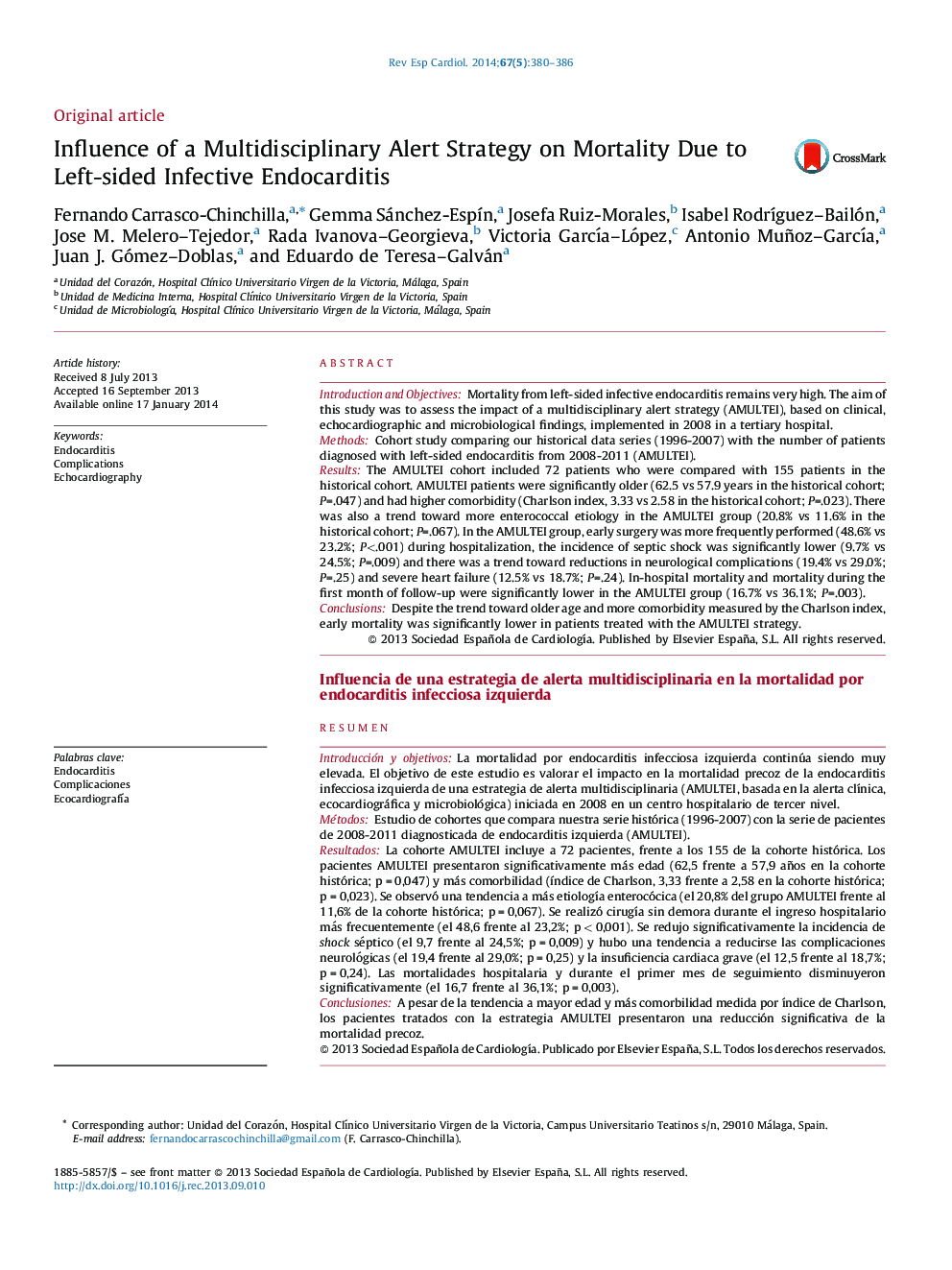| کد مقاله | کد نشریه | سال انتشار | مقاله انگلیسی | نسخه تمام متن |
|---|---|---|---|---|
| 3017565 | 1182124 | 2014 | 7 صفحه PDF | دانلود رایگان |
Introduction and ObjectivesMortality from left-sided infective endocarditis remains very high. The aim of this study was to assess the impact of a multidisciplinary alert strategy (AMULTEI), based on clinical, echocardiographic and microbiological findings, implemented in 2008 in a tertiary hospital.MethodsCohort study comparing our historical data series (1996-2007) with the number of patients diagnosed with left-sided endocarditis from 2008-2011 (AMULTEI).ResultsThe AMULTEI cohort included 72 patients who were compared with 155 patients in the historical cohort. AMULTEI patients were significantly older (62.5 vs 57.9 years in the historical cohort; P=.047) and had higher comorbidity (Charlson index, 3.33 vs 2.58 in the historical cohort; P=.023). There was also a trend toward more enterococcal etiology in the AMULTEI group (20.8% vs 11.6% in the historical cohort; P=.067). In the AMULTEI group, early surgery was more frequently performed (48.6% vs 23.2%; P<.001) during hospitalization, the incidence of septic shock was significantly lower (9.7% vs 24.5%; P=.009) and there was a trend toward reductions in neurological complications (19.4% vs 29.0%; P=.25) and severe heart failure (12.5% vs 18.7%; P=.24). In-hospital mortality and mortality during the first month of follow-up were significantly lower in the AMULTEI group (16.7% vs 36.1%; P=.003).ConclusionsDespite the trend toward older age and more comorbidity measured by the Charlson index, early mortality was significantly lower in patients treated with the AMULTEI strategy.
ResumenIntroducción y objetivosLa mortalidad por endocarditis infecciosa izquierda continúa siendo muy elevada. El objetivo de este estudio es valorar el impacto en la mortalidad precoz de la endocarditis infecciosa izquierda de una estrategia de alerta multidisciplinaria (AMULTEI, basada en la alerta clínica, ecocardiográfica y microbiológica) iniciada en 2008 en un centro hospitalario de tercer nivel.MétodosEstudio de cohortes que compara nuestra serie histórica (1996-2007) con la serie de pacientes de 2008-2011 diagnosticada de endocarditis izquierda (AMULTEI).ResultadosLa cohorte AMULTEI incluye a 72 pacientes, frente a los 155 de la cohorte histórica. Los pacientes AMULTEI presentaron significativamente más edad (62,5 frente a 57,9 años en la cohorte histórica; p = 0,047) y más comorbilidad (índice de Charlson, 3,33 frente a 2,58 en la cohorte histórica; p = 0,023). Se observó una tendencia a más etiología enterocócica (el 20,8% del grupo AMULTEI frente al 11,6% de la cohorte histórica; p = 0,067). Se realizó cirugía sin demora durante el ingreso hospitalario más frecuentemente (el 48,6 frente al 23,2%; p < 0,001). Se redujo significativamente la incidencia de shock séptico (el 9,7 frente al 24,5%; p = 0,009) y hubo una tendencia a reducirse las complicaciones neurológicas (el 19,4 frente al 29,0%; p = 0,25) y la insuficiencia cardiaca grave (el 12,5 frente al 18,7%; p = 0,24). Las mortalidades hospitalaria y durante el primer mes de seguimiento disminuyeron significativamente (el 16,7 frente al 36,1%; p = 0,003).ConclusionesA pesar de la tendencia a mayor edad y más comorbilidad medida por índice de Charlson, los pacientes tratados con la estrategia AMULTEI presentaron una reducción significativa de la mortalidad precoz.
Journal: Revista Española de Cardiología (English Edition) - Volume 67, Issue 5, May 2014, Pages 380–386
